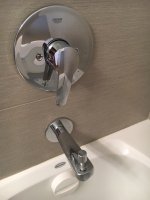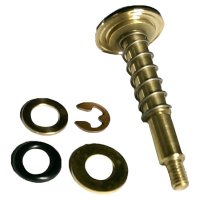OK, it seems things have gotten more "interesting". The problem is that when in "shower mode" (diverter knob pushed down), everything is fine...lots of water comes out of the shower head, and little to none from the tub spout. However, when in "tub mode" (diverter knob up, which is the default position), lots of water comes out both the showerhead and tub spout. I had a chance to check out the diverter mechanism, but everything seemed fine with it. Just for kicks, I decided to remove the spout altogether leaving just the stub sticking out. When I turned on the shower valve, water still comes out both the tub spout and showerhead. So, it seems to me that something funny is going on inside the valve, and the diverter has nothing to do with it. I'm thinking maybe something in the valve is partially blocking the water port going to the tub spout. Any thoughts on this? Something in particular I should be looking for, or maybe a particular place I should inspect? Its a single handle Grohe valve (picture in OP), though I haven't yet been able to identify the particular valve model (yet). All help is appreciated!


